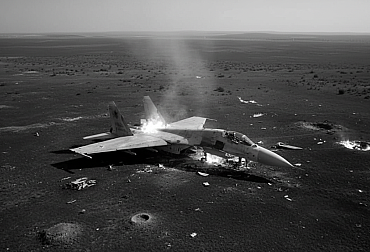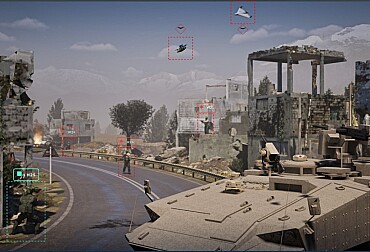First combat use of AI-guided Iranian Shahed Drone alarms Ukraine: Thermal targeting and anti-jamming tech confirmed
Ukrainian defense officials have uncovered compelling evidence that Iran has begun supplying Russia with a new, AI-enhanced version of its infamous Shahed-136 kamikaze drone. The discovery follows a recent overnight Russian strike in which the remains of a previously unseen “MS” variant of the Shahed-136 were recovered and analyzed by Ukrainian specialists.

The debris revealed a range of upgrades that signal a significant leap in Iran’s drone warfare capabilities. Among the most alarming is the integration of thermal imaging targeting, a visible-spectrum camera, and an Nvidia Jetson AI processor, allowing the drone to visually recognize and acquire targets without human input during its terminal phase. This marks the first known use of artificial intelligence for autonomous visual targeting in the Shahed series.
Smart, Stealthy, and Self-Guided
According to Ukrainian military sources, the new Shahed-136 MS is equipped with a four-antenna CRPA (Controlled Radiation Pattern Antenna) satellite navigation system. This advanced GNSS setup is designed to resist GPS jamming and spoofing, which have previously been key countermeasures deployed by Ukrainian forces.
“The addition of machine vision and thermal tracking transforms this from a blind kamikaze drone into a semi-autonomous hunter,” a senior Ukrainian defense official stated under anonymity.
By combining thermal targeting and AI-powered object recognition, the drone can strike high-value targets based on heat signatures or visual markers—such as vehicles, radar dishes, or buildings—even in GPS-denied or heavily jammed environments.
What’s New Under the Hood
While the warhead and propulsion system appear unchanged from standard Shahed-136 designs, the real breakthrough lies in the drone’s guidance package. The use of an Nvidia Jetson module—typically found in civilian-grade robotics and AI development kits—points to a cost-effective but powerful leap in drone autonomy.
The drone’s visible-spectrum camera works in tandem with thermal sensors, enabling dual-mode targeting. This is particularly useful in situations where visual camouflage is used, or during low-visibility conditions, such as night or bad weather.
Ukrainian experts believe this configuration is intended to maximize the drone’s effectiveness against hardened or electronically shielded targets, including mobile air defense systems and key military installations.
A Strategic Game-Changer?
This is the first confirmed combat use of the Shahed-136 MS variant with thermal targeting. Analysis of the impact footage and debris suggests the drone was directed at a heavily defended or mobile high-value target, where traditional GPS-guided kamikaze drones would likely fail.
Military analysts in Kyiv are warning that the appearance of this advanced model may signal a broader trend. Iran appears to be iterating its drone designs for contested environments, possibly in response to operational feedback from Russian forces.
“This is not just an evolution in drone tech—this is Iran proving it can deliver AI-guided weapons on a budget, and at scale,” said a Ukrainian electronic warfare specialist.
Iran-Russia Military Trade Intensifies
The suspected delivery of these upgraded drones points to a deepening military-technical partnership between Moscow and Tehran. Ukrainian intelligence suggests Iran may be trading enhanced drones for access to advanced Russian weaponry—such as air defense systems or fighter aircraft—as Iran’s tensions with Israel and other regional actors escalate.
Although the exact timing of the drone’s delivery to Russia remains unknown, Kyiv believes that the MS variant was introduced recently and deployed directly into combat without domestic Russian testing—possibly indicating growing confidence in Iranian QA standards or sheer urgency on Russia’s part.
What's Next?
Ukraine is now racing to adapt its electronic warfare strategies to counter this next generation of loitering munitions. Officials are urging Western allies to accelerate the delivery of counter-drone systems that can neutralize AI-enhanced threats.
As the battlefield evolves, so do the tools. And the Shahed-136 MS serves as a stark reminder that cheap, expendable drones are becoming smarter—and deadlier—than ever before.







